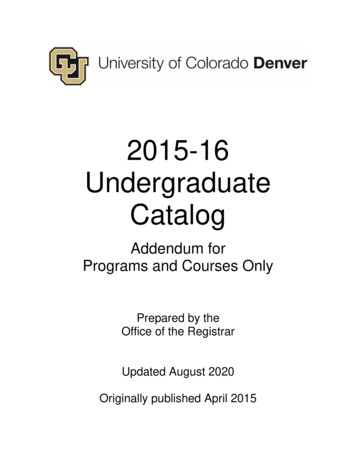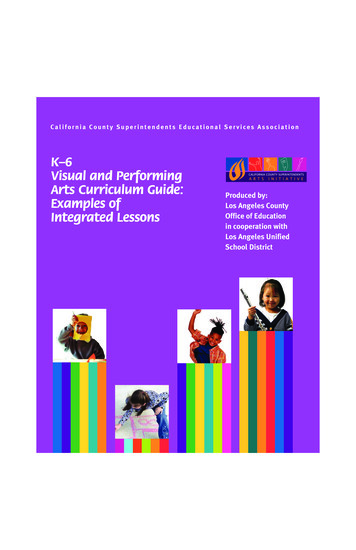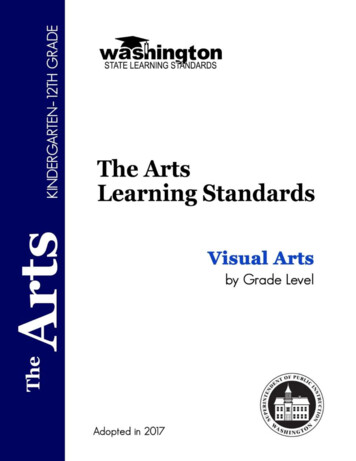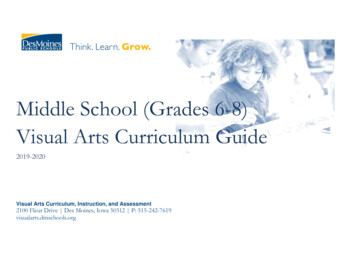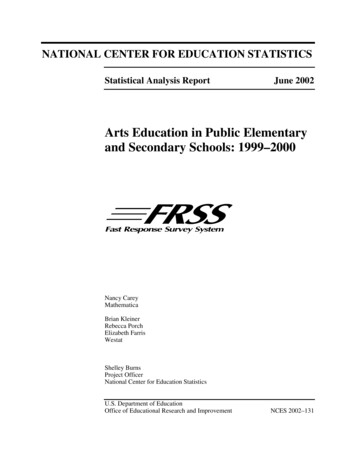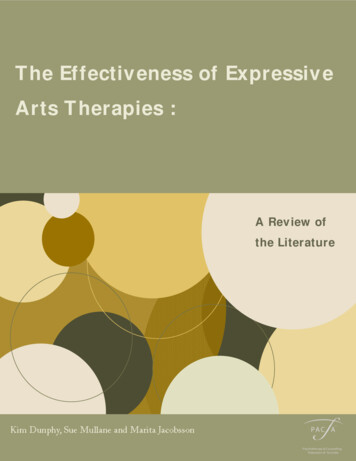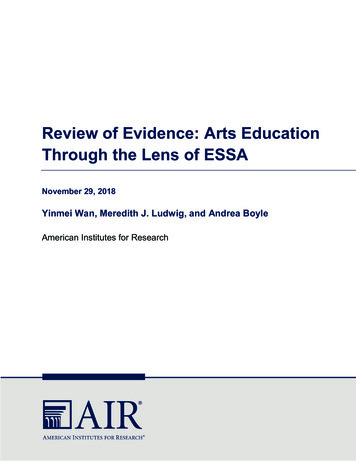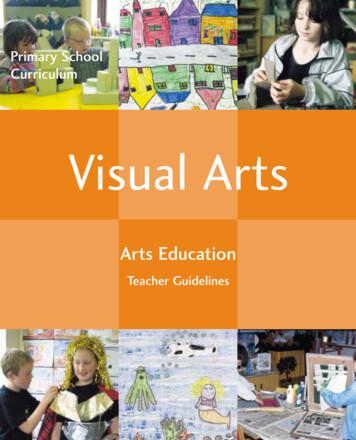
Transcription
Primary SchoolCurriculumVisual ArtsArts EducationTeacher Guidelines
DUBLINPUBLISHED BY THE STATIONERY OFFICETo be purchased directly from theGOVERNMENT PUBLICATIONS SALE OFFICESUN ALLIANCE HOUSEMOLESWORTH STREETDUBLIN 2or by mail order fromGOVERNMENT PUBLICATIONSPOSTAL TRADE SECTION4-5 HARCOURT ROADDUBLIN 2(Tel: 01-6476834-5; Fax: 01-4752760)or through any booksellerDesign Consultancy:Designed by:Photography:Typesetting:Printed by:Bradley McGurk PartnershipThe Identity BusinessChristy McNamaraSpectrum Print ManagementMozzon Giuntina - Florence andOfficine Grafiche De Agostini - Novara 1999 Government of Ireland
Visual ArtsArts EducationTeacher Guidelines
ContentsSection 1Visual arts education in the primary curriculumSection 2The centrality of visual arts education2The visual arts in a child-centred curriculum2The content of the visual arts curriculumStructure and layout6The strands7The visual elements8The emphases in the curriculum11Section 3School planning for the visual artsSection 4Curriculum planning18Organisational planning23Classroom planning for the visual artsThe teacher’s planning28Classroom organisation32Planning a unit of work38
Section 5Approaches and methodologiesA variety of approaches54Drawing56Paint and colour72Print84Clay93Construction104Fabric and fibre110Looking at and responding to art121Looking closely at children’s work128Using information and communication technologies130AppendixSection 6Source references for the curriculum and guidelines134Additional references for teachers136Information sources140Glossary141Membership of the Curriculum Committee for Arts Education146Membership of the Primary Co-ordinating Committee147Acknowledgements148Visual Arts Teacher Guidelines
Exploring the expressive andconstruction possibilitiesof materials
Section 1Visual artseducation inthe primarycurriculum
Visual arts education in the primary curriculumVisual arts education in theprimary curriculumThe centrality of visualarts educationThe visual arts in achild-centred curriculumArt is a unique way of knowing andunderstanding the world. Purposefulvisual arts activities expand children’sways of exploring, expressing andcoming to terms with the world theyinhabit in a structured and enjoyableway.Each child possesses a range ofintelligences and he/she needs a varietyof learning experiences in order todevelop them fully. Visual arts activitiesenable children to make sense of and toexpress their world in visual, tangibleform. They can also be unifying forcesin children’s learning and development:drawing, painting, inventing andconstructing bring together differentelements of children’s experience fromwhich a whole new experience candevelop. Understanding visual imageryopens additional ways of learning forchildren and enables them to recordreal or imagined ideas and feelings.Opportunities to explore and investigatethe visual elements in theirenvironment help them to appreciatethe nature of things and to channeltheir natural curiosity for educationalends. The confidence and enjoymentthat stem from purposeful visual artsactivities can have a positive effect onchildren’s learning in other areas of thecurriculum.Section 1Children first learn to respondaesthetically to their environmentthrough touch, taste, sound and smell,and their natural curiosity suggests aneed for sensory experience. Visual artseducation helps to develop sensoryawareness, enhances sensibilities andemphasises particular ways of exploring,experimenting and inventing. The visualarts curriculum provides for a widerange of activities which enable thechild to develop ideas through imagery,thus providing a necessary balance tothe wider curriculum. Learning in andthrough art can contribute positively tochildren’s sense of personal and culturalidentity and to their wholedevelopment.Children who have had experience inexploring and experimenting with avariety of art materials and media arelikely, as they develop, to produce artthat is personal. A quality visual artsprogramme ensures that each child hasa variety of enriching visual artsexperiences in both two- and threedimensional media.2
Visual arts education in the primary curriculum3Visual Arts Teacher Guidelines
Section 2The contentof thevisual artscurriculum
The content of the visualarts curriculumStructure and layoutThe content of the visual arts curriculumThe visual arts curriculum is structuredto provide a broad-based and balancedprogramme for each of four levels: infantclasses, first and second classes, thirdand fourth classes and fifth and sixthclasses. Each level has six strands, whichare organised to ensure a balancebetween making art and looking at andresponding to art.The strands are Drawing Paint and colour Print Clay Construction Fabric and fibreSection 2Activities in each strand are interrelated and they involve the childrenin perceiving and exploring the visual worldand making art and in looking at andresponding to the visual world and artworks. These activities help to developsensitivity to the elements of the visualworld and to develop the child’s abilityto communicate visually. They involveawareness of line, shape, form, colourand tone, pattern and rhythm, textureand spatial organisation.6The development of perceptualawareness helps children to see and tounderstand the world around them andto express their ideas, feelings andexperiences in visual form. Attentivelooking helps them to make connectionsbetween their own work and the work ofothers. It also helps to developconcentration and the ability to focusattention generally. These experiencesare an essential part of every art lesson.A threefold structure is suggested forchoosing thematic content or subjectmatter, based on children’s experience imagination observation and curiosity.This structure provides opportunitiesfor children to give visual expression toinner concerns which may be difficultto put into words, to give expression tothe wonderful world of the imagination,and to pursue their curiosity in thephysical attributes of the world. Veryoften two or even three of these arebeing drawn on in a single art activityor project, at varying levels of emphasis.
The strandsDrawingPaint and colourChildren develop an understanding andappreciation of colour from observationof and delight in colour seen in natureand in manufactured objects, and theyuse colour to express their experiences,interests and imaginative ideas. As theyprogress they demonstrate a developingawareness of colour in their own work,a growing sensitivity to other artists’expressive use of colour and its impacton crafted and designed objects.PrintThrough experiences in print-making,children learn to focus attention on anddeepen their understanding of graphicprocesses. They have opportunities toexperiment with print-making techniques,to use them inventively, and to produceprints for functional use as well as fortheir own sake. As they progress theylearn to take a more thoughtful approachto shape, edges, layout and compositionClayChildren enjoy the freedom to form andchange clay and to use it imaginatively.Through experience of clay and from aneed for expression, they learn the skillsof forming and changing it in increasinglypurposeful ways. As well as sculpturalexpression, they have opportunities todesign and make objects for use andwear (the latter to a limited extent inthe absence of a kiln), using theirpowers of invention and expression.Developing sensitivity to underlyingform in the environment and in artworks enables them to enjoy andappreciate great sculpture and toappreciate craft objects critically.The strandsChildren soon discover drawing asa natural way of communicating experience. Through drawing, they createand express imaginary worlds and givefree expression to their imaginativepowers. Older children also use drawingto clarify, develop and communicateplans. As they progress they demonstratea developing visual awareness in theirdrawings and a sensitivity to the expressive powers of other artists’ drawings.in print-making and develop sensitivityto the expressive qualities in the workof graphic artists.ConstructionConstruction activities provideopportunities for exploring imaginativeworlds in three-dimensional media.Children are encouraged to makeimaginative and expressive use ofmaterials for designing and inventingand to make models to their owndesign. This involves exploring thepossibilities of the materials, experimenting with new ways of balancing andcombining them, and developingunderstanding of structural strengthsand possibilities. Experience inconstruction helps children to look withcuriosity and enjoyment at structures innature and to develop sensitivity to andVisual Arts Teacher Guidelines7
appreciation of the structures of greatarchitects, sculptors, and craftspeople.The content of the visual arts curriculumFabric and fibreThe visual elements lineSection 2 shape form colour and tone pattern and rhythm texture spatial organisation8Work in fabric and fibre helps childrento be curious about how everydayfabrics are structured and developsgreater sensitivity to colour and tone,texture, line and shape. They areencouraged to use fabric and fibre asmaterials for imaginative invention inboth two- and three-dimensions, forexample to use free stitching as a way ofchanging or developing a fabric surface;to create their own fabric, using fibreimaginatively and with a developingrange of techniques; to use fabric andfibre to interpret three-dimensionalnatural forms, and to expressimaginative play through puppets andcostume-making.Through work in fabric and fibre,children begin to understand some craftprocedures and skills and some of thecreative design processes in craftweaving, knitting and fashion design, forexample. As they progress they developthe ability to appraise craft materialscritically for suitability for a particulartask, as well as the artefacts and artworks that are carried out in thesemedia.The visual elementsA basic understanding of the visualelements is essential to purposefulteaching in the visual arts. Line, shape,form, colour and tone, pattern andrhythm, texture and spatial organisationare the basics of two-dimensional andthree-dimensional composition. Theteacher should be aware of the visualelements and informally draw attentionto them as they arise in the children’swork, in the work of artists and in theobserved environment. Awareness of theelements and their interplay is essentialto quality design in both two and threedimensional work, including craft. Adeveloping visual vocabulary and agrowing ability to think visually andspatially help to focus children as theystrive for visual expression.LineLine is the basic element in children’searly drawings. In art work, line cancreate shape, pattern, movement andunity in a composition. Line can bethick, thin, textured, delicate, bold,curved, straight, continuous or broken.Children soon discover that lines canmake shapes and they use them toinvent their symbols.
LineShapeFormColour and tonePattern and rhythmTextureSpatial organisationThe visual elementsLineVisual Arts Teacher Guidelines9
ShapePattern and rhythmShape is created by merging, touchingand intersecting lines. It can also bedefined by colour and tone and bytexture. Everything has a silhouetteshape as well as other internal shapes.The shapes that emerge between shapesare called negative shapes. Shapes canbe regular or irregular, closed or open.Pattern is the constant repetition, withvariation, found in everything from thepattern of sea shells to the forms of hillsand clouds. The teacher draws attentionto pattern and rhythm in nature, in artand in the children’s work as it arises.Children can use pattern and rhythmas a design element in two or threedimensional compositions to achieveunity, variety, movement and directionalforce.The content of the visual arts curriculumFormForm is the name given to threedimensional shape. It is solid. Formcan be modelled in clay, Plasticine orpapier mâché. Ways of suggestingthree-dimensional form on a flat plane(surface) are explored through drawingand painting.Colour and toneSection 2Colour in art is referred to in termsof hue, tone, intensity and temperature.The basic characteristic of pure colouris called hue, for example yellow, red,blue. Tone is the lightness or darknessof a hue. Intensity refers to the relativestrength or weakness of a hue. Temperature in art terms (but not in precisescientific terms) refers to the warmand cool halves of the colour spectrum.Developing awareness of colour andits impact on everyday life is vital todeveloping children’s visual awarenessand awareness of the effects they cancreate with colour in their own work.10TextureTexture is the roughness or smoothnessof a surface. Everything has texture.Surfaces may be silky, shiny, hairy orbumpy, for example. Texture is animportant aspect of the visual and notjust the tactile world. Children needopportunities to work on variouslytextured surfaces and to discover theirown ways of suggesting textures seenin nature.Spatial organisationSpatial organisation in two-dimensionalwork is concerned with creating anillusion of space and depth on a flatsurface and also with organising theflat picture plane. Three-dimensionalwork (construction, for example)involves finding ways of working withvarious closed or open spaces orcompartments to create structures: thisapplies to non-representational as wellas to representational or imaginativestructures.
The visual elements in contextThe emphases in this curriculum are: understanding the creative processchildren go through in making art understanding the stages ofdevelopment in children’s art andtheir relevance for drawing inparticularThe emphases in the curriculumLearning in art is activity-based anddevelopmental and it builds on children’sprevious experience in different media.Children develop awareness of the visualelements and their interplay throughmaking art and through looking at andresponding to art works. While they haverelevance for all six strands, attentionshould be drawn to them informally, incontext and without undue emphasis atprimary level. Children learn to use line,shape, colour and tone, pattern andrhythm and texture expressively and fordesign purposes through opportunitiesto look closely at the visual environmentand to draw and paint themes that havepersonal meaning for them. Simpleprint-making and creative work infabric and fibre help to further thisdevelopment. Children acquire a veryimmediate sense of form through workingwith clay. How people, objects or abstractelements relate to each other in space isa primary concern in the art of childrenas well as in that of artists. Young childrenstruggle very creatively with this andinvent their own ways of suggestingspace. Older children, who generallywant things to look ‘right’, will beinterested in seeing how artists solvespatial problems in non-representationalas well as in representational work.Careful planning ensures thatopportunities for developing visualawareness are built in to every art lesson.The emphases in thecurriculum the provision of a broad, six-strandcurriculum to which drawing iscentral and which incorporatesart, craft and design activities ina balance of two- and threedimensional media balancing opportunities to make artwith opportunities to look at andmake a personal response to art.The creative processIn making art, the process of makingis as valuable as the final product.The emphasis is on exploring andexperimenting with the expressivepossibilities of different materials, toolsand media and with the choices theyoffer for different tasks. Talking abouttheir work and, when appropriate, asthey work is central to this process.The atmosphere during the art classmust always be challenging, motivatingand supportive and must allow thechildren to express understanding oftheir world in a personal way. The teachermust constantly be alert to their needsVisual Arts Teacher Guidelines11
and successes to ensure that they areinvolved in a creative rather than in apassive or imitative way.Section 2The content of the visual arts curriculumTo focus concentration and encourageeffort as children work, the teacher movesamong them, discussing, questioningand, where necessary, directingobservation and helping to rekindleinterest that has waned or courage thathas failed. The teacher should be sensitiveto when such intervention would behelpful and when not. When childrenare disappointed by their efforts, theirdifficulties are discussed to help thempinpoint the problem area. Positiveaspects should also be discussed,for example how well they saw andinterpreted a particular curve, shape,colour or mood. Questions should bedesigned to elicit a visual and at timeskinaesthetic response and to stimulatethe children to further concentrationand involvement: I like that colour: how did you makeit? Was that your favouritejumper/dress? Did it have a designon it? Do you remember how your legswent when you were running? Can you show me the way the dog’smouth went when he snarled at you? Can you make a big movement withyour hand to show me the way thattwig curves/the flow of your friend’slong hair/water going down thesink?12The task of the teacher is not to teachclever techniques or to demonstrateways of producing images and formshe/she finds acceptable but to buildon interests and strengths by drawingthe children out and making suggestionsas appropriate. Children should not betaught to follow instructions unquestioningly, as this is likely to hinder creativityand spontaneity. They should be helpedto appreciate the value of workingindependently and on their own initiative,and experimentation and interpretationshould be encouraged equally in twoand three-dimensional work. In an artlesson, the children should remain thedesigners: this role should not be takenfrom them.Extra care should be given to consideringthe creative process when integratingwith other curricular areas: it is possibleto combine different sets of objectiveswithout losing the integrity of any.
The stages of development inchildren’s artChildren should be encouragedto use drawing to plan their artactivities.The curriculum provides opportunitiesfor activities that incorporate art, craftand design in two- and threedimensional media, both in makingactivities and in responding to works ofart, craft and design. The twodimensional media are drawing,painting and print, and they includecollage. The three-dimensional mediaare clay, construction and work in fabricand fibre, some of which havetraditionally been referred to as craftactivities and are now further developedas a creative process. It is important tomaintain a balance between activitiesin two- and three-dimensional media togive children a real sense of the threedimensional nature of the world theylive in as well as an imaginative capacityfor expressing it on a flat surface.The emphases in the curriculumIt is important to maintain abalance between activities intwo- and three-dimensionalmedia.Patterns of development are discerniblein children’s art up to the end of primaryschooling. They are most evident inchildren’s imagery and they provide abroad outline of typical progress. Theybegin with mark-making and so-called‘scribble pictures’ and may develop towhere realistic representation is themain concern. A personal set of symbols(their own visual interpretations) willtypically evolve for familiar objects andfigures, such as a person, a tree or ahouse. The development of a ‘scheme’(schema) for expressing ideas may resultand may be used in their story-telling.As they progress, it is important to helpthem develop beyond symbols which areused with little variation. They shouldalso be encouraged to use drawing toplan their art activities, for example ifthe theme is to be carried out inanother medium. An understanding ofthe stages or patterns of development inchildren’s art is crucial to the objectiveassessment of children’s visualexpression, and to planning.The six-strand curriculumDrawing has primary importance inthis curriculum. It is through drawingthat children’s development in art ismost evident. Because it is somethingmost young children do naturally, it isparticularly important in promotingvisual awareness and the ability torecord what is seen, felt or imagined.Drawing activities also help to develop aconfident and expressive use ofmaterials and tools.Visual Arts Teacher Guidelines13
Making art and respondingto artSection 2The content of the visual arts curriculumThe curriculum places much emphasison attentive looking, both in making artand in responding to art. Art activitiesare structured to help children developsensitivity to their visual surroundingsand to art works and to make connectionsbetween what they observe and theirown work. Children’s developing abilityto observe closely and to interpretwhat they see is the basis for expressionand design. They need opportunitiesfor close observation of the naturaland living environments as well asopportunities to see how artists,craftspeople and designers interpretthem. They should have access to avariety of art styles from different timesand cultures as stimulus for their ownart activities, as a way of makingcomparisons between differentinterpretations of an idea or theme,or simply for the pleasure they give.The emphasis should always be on artas inspiration, and not as somethingto copy.Children are constantly bombardedwith aggressive advertising imageswhich are designed to deliver theirmessage in the shortest possible time.The deeper, subtler and more meaningfulvalues that can be appreciated in art,however, take more time. The teacher’stask is to help them to look at art worksfor a longer period and with a moreopen attitude than they might otherwisehave done. Openness to art enables14children to evaluate art works in acritical and personally meaningful way.Their attention span and powers ofconcentration expand and deepen withcontinued exposure to a wide variety ofart works.Preparation could include deciding on how much information to give onthe artist’s life and methods at what point in the class to give thisinformation compiling a list of questions basedon the art work and designed tostimulate the children’s visualfaculties whether to follow up with a practicalactivity.It is important that children are enabledto make connections between the workof artists and their own work. They shouldbe encouraged to discover and talkabout variety in visual expression fromdifferent times and cultures, its role inthose cultures and how it differsperhaps from today’s. As they progressthey should also have opportunities toanalyse and discuss the visual imagesthat have such a strong influence ontheir ways of seeing the world, forexample images projected by television,posters, advertising, magazines andstreet fashion. This would be helpfulin developing a feeling for graphicsand design.
CraftDesignDesign has a very important role to playin the primary curriculum, and can bedefined as active planning, inventing,making and relating parts to a whole ineither two- or three-dimensional media.It is not an isolated discipline butunderlies every art and craft activity,whether the end in view is expressivecommunication or the creation of auseful object.Close observation of the world aroundthem enriches children’s visual awarenessand the vocabulary on which to drawfor expression and design. Drawingattention to well-designed objectsand buildings helps them to developsensitivity to good design and theability to form and design their world.Many types of design activities provideChildren make design-related decisionswhen, for example, they make decisions about the layout oftheir workThe emphases in the curriculumIt is important that children areintroduced to a wide range of craftprocesses to help develop sensitivityto and appreciation of beauty, goodtaste and good workmanship. As wellas being intensely enjoyable, experiencesin looking at and handling well-designedcraft objects help to develop discrimination and a critical faculty. Childrenshould also become familiar withtraditional Irish crafts, especially withliving local crafts: visits to local orregional craft workshops could well beamong their most memorable learningexperiences. Experimental ways ofworking with craft materials shouldbe explored.valuable experiences at all stages ofprimary schooling when they promoteobservation, invention, expression andcreativity. enrich a surface with pattern anddetail change a piece of fabric purposefullyby removing from or adding to it,even in infant classes choose scraps of cloth or paper for acollage and make decisions aboutwhere to position them rework a sketch for use as a designin another medium, for examplemaking changes to a drawing fromnature for use as a print plan to make something to their owndesign: trying to visualise it; makingsketches and plans for it; thinkingabout the materials they might useand how they might use them, forexample a costume for use in drama,or a working three-dimensional model plan to make a functional object inclay, for example, and make decisionsabout how its functional demandsmight be met.It is in these contexts that designawareness has an important part toplay in primary school art.Visual Arts Teacher Guidelines15
Varieties of paper, card andfabric are suitable surfacesfor print-making
Section 3Schoolplanning forthe visual arts
School planning for thevisual artsThe successful implementation of thecurriculum will depend on carefulplanning. It should be planned for asan independent, balanced and cohesiveprogramme within a broad arts educationcurriculum and as a vital component ofthe overall school plan. Planning for thevisual arts is a consultative and collaborative process involving the principaland teachers and, where appropriate,parents and the board of management.School planning for the visual artsPlanning should be twofold: curriculum planning organisational planning.Curriculum planningThe issues that may need to be discussedas part of the school’s planning for thevisual arts include the following:Section 3The importance of visual artseducation in the schoolcurriculumTheme-based activities thatincorporate a number of mediawould, where appropriate, bedesigned to achieve theobjectives of a number ofstrands.18Curriculum planning begins withacknowledging the central role of visualarts education in the child’s holisticdevelopment. The creative processchildren go through in making art, thestages or patterns of development intheir art and the importance of visualarts education as a way of knowing thatcomplements other areas of learningshould be among the topics discussed.The emphasis on the creativeprocessThe creative process children gothrough in making art is emphasisedbecause a significant part of learningin art occurs in their approaches to thetask in hand, and this may not beevident in the finished product.A broad and balancedcurriculumPlanning should ensure that all childrenhave a broad developmental programmein drawing, paint and colour and in athree-dimensional medium such as clay,as well as in print-making, constructionand work in fabric and fibre. The latterthree may in part be replaced by workin other appropriate media, which couldinclude photography, film studies orcomputer graphics, for example.Theme-based activities that incorporatea number of media (for example drawing,paint and colour, construction) would,where appropriate, be designed toachieve the objectives of a number ofstrands in the same activity, and theschool plan would ensure that thenecessary balance between work in twoand three-dimensional forms ismaintained. School planning shouldalso provide for opportunities to see, toreflect on and to appreciate art formsfrom our own and other cultures,whether at first hand or in reproduction.A broad and balanced curriculum ensuresthat children have the experiencesneeded to develop the concepts andskills that underlie visual expression.
Children with differing needsThe curriculum providesopportunities for children withspecial educational needs toshow capabilities andindependent achievement.All children should have equal accessto visual arts education. The schoolplan should guarantee opportunitiesto participate in purposeful activitiesthat draw on their creative and aestheticpotential. When planning for equalopportunity, which would includeequal access for boys and girls, staffmembers might discuss attitudes toart and the values it holds for them.The curriculum provides opportunitiesfor children with special educationalneeds to show capabilities andindependent achievement. Their stage ofdevelopment in art must beacknowledged, regardless of age: theirvisual imagery is a way of expressingtheir understanding of the world andthey must be allowed to developthrough it. Activities and guidelinesshould therefore be adapted to suitindividual needs and should beappropriate to the child’s ability andage. Where relevant, activities shouldbe planned in manageable, sequentialunits, and children should be allowedsufficient time to complete each unit.Brief, one-session art activities may bemore suitable for children with a shortattention span, and kinaesthetic, multisensory activities may sometimes beappropriate. With support, interestand praise for their efforts, childrenwill respond enthusiastically.Curriculum planningThe circumstances and environment ofthe school, the local traditions in thevisual arts and the range of interestsand aptitudes of the children willinfluence the selection of activitiesand topics. Staff members’ interestsand levels of expertise in the visualarts would also be important factorsin implementing the programme andshould be recognised.In any class, children may be working toobjectives within a range of levels. Somechildren with learning difficulties ma
the wider curriculum. Learning in and through art can contribute positively to children's sense of personal and cultural identity and to their whole development. The visual arts in a child-centred curriculum Each child possesses a range of intelligences and he/she needs a variety of learning experiences in order to develop them fully. Visual .

